|
 |
The Memotech MTX Series |
 |
MTX Network File Server (NFX)
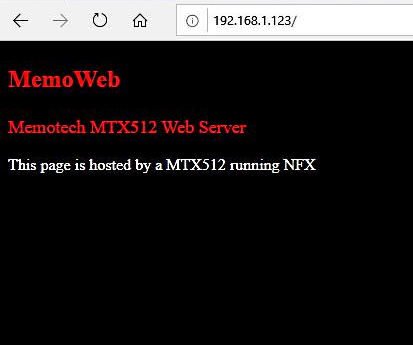
Hardware Courtesy of Martin Allcorn
Webserver by Andy Key
(with enhancements by Bill Brendling)
FTP Capability
added by Bill
OK, nobody is going to attempt to run a website hosted on a
Memotech MTX, but the hardware now exists that would make it
possible! Back in 2017, Martin and I had discussed the
feasibility of adding a network interface to a MTX computer, but
at the time, it was just a pipe dream - or so I thought . . . .
|
Design & Build - NFX Version 1 |
In mid June 2017, Martin gave me a heads up on something
new that he'd been working on in the background.
He sent these
photos showing a mysterious new component added to a
pretty bare piece of prototyping board with a Compact
Flash card reader attached and a ROM identified as
"NFX".
The mysterious component turned out to be
a
Wiznet W5100, a Hardwired TCP/IP embedded Ethernet
controller. Supporting documentation can be found on the
Wiznet site, including :-
Datasheet
Datasheet Errata
Application Note
Hardware Design Guide
I/O Library (Driver) |
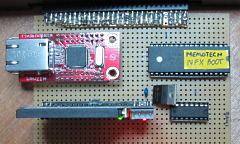 |
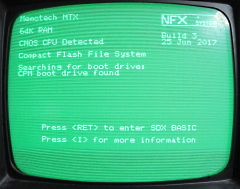 |
As noted on
the Wiznet site, the main features of the W5100 are:
- All-in-one Ethernet Controller
- Hardware TCP/IP, MAC & PHY
- Fully hardwired network protocol
- Direct & Indirect Bus and SPI for Host
Interface
- Stable Data Communication
|
"W5100 suits users in need of stable Internet
connectivity best, using a single chip to implement
TCP/IP Stack, 10/100 Ethernet MAC and PHY. Hardwired
TCP/IP stack supports TCP, UDP, IPv4, ICMP, ARP, IGMP,
and PPPoE."
Martin was attempting to provide the
MTX with Ethernet connectivity!
At this stage,
the hardware was connected to a cut-down
CFX-II board
(which uses an 8 bit CF connection) running a copy of
the SDX BASIC ROM. The W5100 was configured to use Z80
I/O addresses 160-167 decoded by the HCT138. (4 Ports
are being used, but for simplicity, each is presented
twice.) |
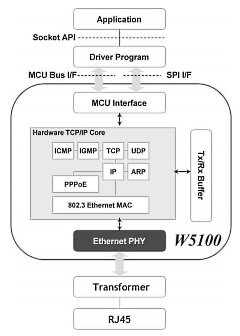 |
Port 160
(164) is the control port, the W5100 is setup in
indirect mode.
Port 161 and 162 define the memory
address in the W5100's RAM
Port 163 is the data
Martin was quickly able to get the MTX communicating
on the network, here you can see that the device has
been configured with IP address 192.168.1.253 and is
happily responding to pings from a Windows command
prompt. |
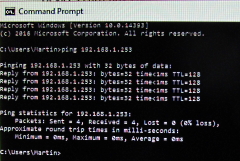 |
However,
Martin realised that getting the hardware working was
the easy part (his words) and that writing the software
to get best use from the device was going to be a
challenge for him and suggested that the "real
programmers" in the Group might be best placed to take
the software further.
I suggested that Andy's
skills in that area could be leveraged. It was
convenient that
Memofest
2017 was coming up. Hopeful that Andy could work his
programming magic on the NFX hardware, Martin presented the NFX
prototype board to Andy, along with a challenge to get
an MTX on the internet . . . . |
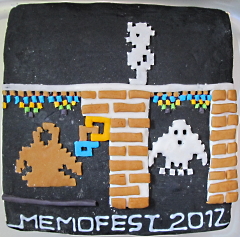 |
By the time
that
Memofest 2018 came around, Andy had indeed been able
to use NFX to get an MTX computer communicating over
TCP/IP, to such an extent that he had a working
webserver that was demoed during the event.
For full details of the clever
coding behind Andy's webserver, see his
Memofest 2018 report and his dedicated
NFX page.
NFX.COM provides the NFX hardware with standard TCP/IP
functionality, supporting the chargen,
echo and http
services. |
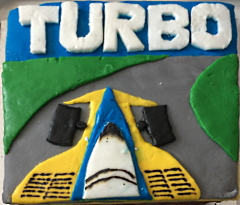 |
The
prototype NFX board attached to a Martin's MTX (with
orange coloured function keys from a BBC Micro).
The display shows the output from Andy's NFX.COM
program as it serves web pages to a network attached PC.
(Photo courtesy of Andy Key) |
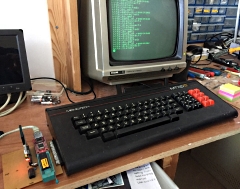 |
Screen
output from NFX showing activity of the services,
including
| http_listen |
listening for http requests |
| http_connected |
a connection has been established |
| http_do_get |
remote has requested a file |
| http_send_ok_response |
successful send |
| http_disconnect |
connection closed |
The server supports up to 4 simultaneous connections,
here, two are http services and you can see interleaving
of messages from the different services |
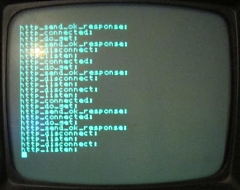 |
Software Development - NFX.COM
Andy has implemented three network services in his NFX code :
| Service |
Port |
Description |
|
chargen |
19 |
Character Generator. A debugging tool that causes
the server to send a stream of character data to the
client.
This can be demonstrated under Windows using
telnet connected on port 19:
telnet 192.168.1.123 19
(Type <ctrl><]>
to interrupt the chargen stream, then quit
to exit telnet) |
|
echo |
7 |
Echo Service. A debugging tool that causes the
server to echo characters received from the client.
This can be demonstrated under Windows using
telnet connected on port 7:
telnet 192.168.1.123 7
(Type <ctrl><]>
to stop sending characters, then quit
to exit telnet)
The echo service is also responsible
for responding to network
ping commands and can be used to confirm that NFX is
"alive". (Although, NFX does not report that the echo
service is connected in the same way that is does when
echoing text over Port 7.) |
|
http |
80 |
A simple web server - this is the really useful one!
As well as giving the MTX the ability to service web
file requests, the http protocol allows files to be
transferred to and from a PC. |
On
his website,
Andy demonstrates the use of
curl to
interface with the http service running on the MTX. curl is a
command line tool used for transferring data using a number of
network protocols, including http. (Windows versions of curl are
available from the haxx
website.)
The http service provides limited file
transfer capabilities such as read, write and delete :
| Function |
curl syntax |
| write file from PC |
curl -X POST --data-binary @index.htm
http://192.168.1.123/index.htm |
| delete file from MTX |
curl -X DELETE http://192.168.1.123/index.htm |
| read file from MTX |
curl http://192.168.1.123/index.htm |
| read and save a file |
curl --output <destination file>
http://192.168.1.123/<sourcefile> |
Martin recently sent me one of his prototype boards for me to
try out. I can confirm that it works well. My
original goal of having network connectivity to the MTX was to
facilitate file transfer over my local network and at this
point, NFX is able to do that.
I created a test html page
called index.htm and was able
to "post" it to the CFX CF card on the MTX using the
syntax above.
The NFX web server was able to
display the file in my Windows browser as shown here. |
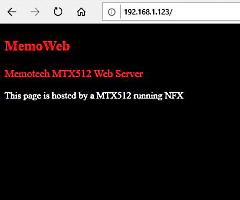 |
Reading files using the http service is supported, but curl
normally expects the file to be displayed on the user's screen,
or more accurately, on stdio, rather than saved to disk, but
save to disk is possible by specifying additional parameters in
the curl command.
A non-printable file, such as a binary, can be saved from
your browser in the normal way, e.g., specifying NFX.COM in the
URL will display the normal dialog that allows the file to be
saved or executed - though attempting to run the file is
obviously a bad idea!
Limitations
The http service does not support the use of wildcards and does
not support getting a directory listing. Better support for file
transfer would require that an ftp service was created in NFX,
but that may not be feasible.
The IP address of the server is hard coded into NFX. The chosen
address (192.168.1.123) falls right in the middle of the DHCP
range I use for my network. I will either need to modify the
address in the source, or to give more flexibility, try to
modify the source to allow the network parameters (IP address,
subnet mask and default gateway) to be specified on the command
line or in a configuration file.
It is not possible to break out of the program on the MTX,
probably due to interrupts being disabled, the only way to stop
the services is to restart the MTX. That's not much of an issue,
but being able to gracefully stop the program, perhaps by
sending a command to the server, would be a nice addition.
Hardware Development
Only two instances of the Version 1 prototype exist, courtesy of
Martin, Andy has one and I have the other. NFX was never
intended to be a standalone product, it was essentially a proof
of concept to prove that network capability could be added to
one of our "disk drive" add-ons for MTX or
MTXPlus+.
As of August 2020, it had not actually made it into any other
products, but the design continued to evolve. The prototype
NFX boards are the absolute minimum required to get the
"net" up and running. Andy's NFX software works with either, as
the major difference between the 2 Wiznet boards is the removal
of the unused (by NFX anyway) memory mapped mode.
See the bottom of the page for an exciting new product that
includes the capabilities of NFX.
|
Design & Build - NFX Version 2 |
The Version
1 boards use a
WIZ811MJ network module, which used a W5100 self
contained TCP/IP controller.
|
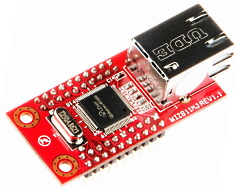 |
Version 2
of the design uses the newer
WIZ810SMJ, which has the W5100S fitted
|
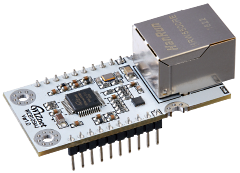 |
The Version
2 prototype board. There is one 8k ROM image, which is
running a modified CPM BIOS using the VDP for a 40
column display.
The CF is connected an 8 bit IDE
interface on the same I/O ports as CFX-2. The actual
connections for the IDE and Net module are very similar.
The only other components on the board are a 74HC138
doing the I/O decode for IDE and Net and a 3.3v LDO to
power the net module.
The 8 bit IDE interface
uses ports B0 to B7, and the W5100 uses 4 ports A0 to
A3, (those are shadowed on A4 to A7 due to decode
limitations). (The jumper on the test board
selects ports 90-93 instead, suggested by Andy to avoid
the I/O clash with Rememorizer's floating point
hardware.) |
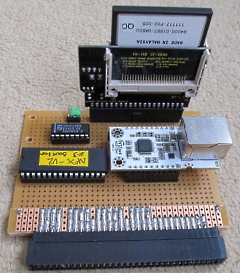 |
| Theoretically the
NFX code should run from any MTX filing system, it's not
restricted to CF, CF just happens to be easy to build
for. |
Solder side
of the Version 2 prototype board.
It's not as
complicated as some of Martin's other wired boards, but
it's still a lot of work - done to Martin's usual high
standards.
It's so much easier to let Martin do
the prototyping & testing, then just get PCBs made :-) |
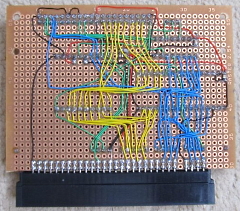 |
| |
|
|
|
|
Software Development - NFX.COM
To my mind, the limitations mentioned above, mainly the fixed IP
address and being unable to get a remote directory listing,
compromised the effectiveness of NFX and deserved some
attention. Being unable to tackle these issues myself, I
asked for help on the Memotech forum. Bill Brendling
rose to the challenge and was soon able to make significant
enhancements to NFX.COM.
The first enhancement that Bill implemented was having
the http server return a file listing from the CFX
directory.
If no filename, such as
index.htm, is appended to the IP address,
NFX will return the directory listing in html format.
Common internet related file types such as HTM, CSS,
JS, GIF, PNG, JPG, TIF, or files recognised as text, can
be displayed by selecting the filename. Selecting other
filenames, including executable (COM) files presents the
usual browser dialog which allows the file to be saved. |
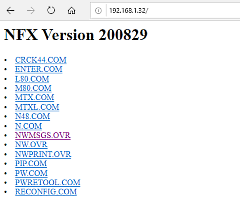 |
The filenames can also be retrieved using curl
e.g., curl
http://192.168.1.32/
If a
filename is entered, it will be "printed" to the
console, or, the output can be directed to a file
e.g., curl --output nfx.log
http://192.168.1.32/nfx.log |
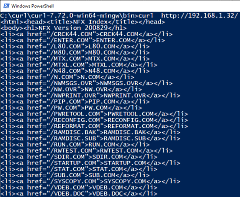 |
Observant readers will note that the MTX now has address
192.168.1.32, this is possible because Bill has
implemented reading the network parameters from a
configuration file at startup. The configuration file
should be called
nfx.cfg and can contain up to 4 parameters
which should be entered in the order and format shown
(without the parameter names)
| Parameter |
Example |
Comment |
| IP address |
192.168.1.32 |
mandatory |
| Subnet Mask |
255.255.255.0 |
optional |
| Default Gateway |
192.168.1.1 |
optional |
| MAC Address |
00:08:DC:4E:46:58 |
optional |
If only the IP address is to be
changed from the defaults, lines 2-4 may be omitted. If
nfx.cfg does not exist, defaults will be
used.
Other enhancements include the ability to
terminate the program by pressing the "q" key on the MTX and the
option to log program output to a file. The program accepts one
argument which should be the name of a file to log the program's
output. The filename should be specified in the usual 8.3 CP/M
filename format, if no name is entered, the program will run
without logging.
|
NFX.COM Program Download |
 |
(Coming
soon) |
| |
|
MTX File Write Speed
Reading files from the MTX to a PC is pretty fast, but
sending files the other way is exceedingly slow, expect
something like 0.5-1k per second! That speed would likely be
unacceptable for frequent use, but, for occasional use, it may
be acceptable. The bottleneck is not the NFX interface - reads
and writes through the interface take place at the same speed,
the bottleneck is the speed of writing the file by CP/M.
CPM that is slow at writing for 2 reasons :
- De-blocking CP/M's 128 byte sectors onto the CFX's
512 byte sectors is a lot of work. When writing a file, CP/M
has to go looking for blocks to allocate, when reading
they're in the FCB ready. For every 128 bytes written, the
CFX code has to read 512 bytes into the buffer, update 128
bytes and write 512 bytes back. If the next CPM sector
written is in the same CF sector the read step can be
skipped. So the best possible speed for 4 consecutive
sectors needs 1 CF sector read and 4 written, Which is 2560
bytes transferred 5 times as long as reading, Worst case
would be 8 to 1 when writing 1 CPM sector that's not already
in the buffer, which needs 1024 bytes transferred to write
128 bytes.
- The free block search time is variable, but takes longer
the further it has to go into the disc map to find an unused
block. So scanning a typical CFX B drive of a 1/2 full 8
meg partition cloned from ReMemorizer isn't going to help!
Because of these limitations, it will not be possible to
increase the speed when savings files to the MTX over the
network, however, even with this limitation, I think that it us
a really useful enhancement to an MTX.
Update : Bill has been able to optimise the file writing
capabilities of CFX based hardware (replacement ROM required).
Software Development - FTPD.COM
Although transferring files using the http protocol works well
enough, I had hoped that a proper FTP server might be possible
but didn't think that would happen. However, Bill has devoted
some time to researching the FTP protocol and has developed an
FTP server for the NFX hardware.
The program uses the
same configuration file as NFX.COM (nfx.cfg)
and also accepts one optional argument, the name of a file to
log the program's output.
|
FTPD.COM Program Download |
 |
Version
220530 - Configurable WIZnet I/O Port Range (MFX) |
 |
Version
201031 |
| |
|
Screen shot of
FileZilla running under Windows 10 and connected to an
MTX512 with NFX hardware and FTPD running. As well as allowing
easy file transfer between the MTX and a PC, the tool makes
housekeeping on the MTX disk (CF) much simpler. File management
is much easier than using native CP/M commands or CP/M add-in
programs.
NFX has grown from being able to function as a basic web server
into a really useful tool for providing network connectivity for
the MTX. In May 2022, we announced MFX
- the Memotech Multi Function Expansion card which incorporates
the functionality of NFX and includes VGA output and an SD card
based "disc" system. MFX is expected to start shipping by August
2022.
|